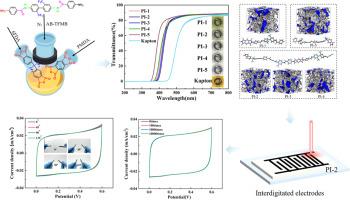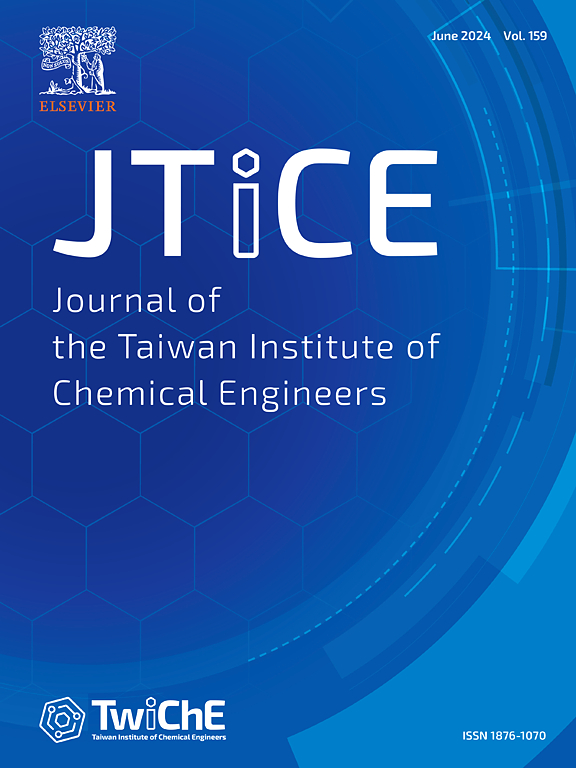Modulation PI film performances to fit flexible substrate of transparent supercapacitors
IF 5.5
3区 工程技术
Q1 ENGINEERING, CHEMICAL
Journal of the Taiwan Institute of Chemical Engineers
Pub Date : 2024-09-24
DOI:10.1016/j.jtice.2024.105772
引用次数: 0
Abstract
Background
With the increased demand for energy storage devices, transparency, flexibility, and miniaturization are gradually becoming the future development direction of energy storage devices, among which supercapacitors have unexceptionable application potential. However, due to the limitation of substrate material, the flexibility, transparency, thermal properties, and mechanical properties of supercapacitors cannot be perfectly unified.
Methods
Herein, we fabricated a series of transparent Polyimide (PI) films by combining para-amide-linked diamine (AB-TFMB) with different ratios of Pyromellitic dianhydride (PMDA) and 4,4′-(Hexafluoroisopropylidene)diphthalic anhydride (6FDA). A series of characterizations were conducted regarding the thermal stability, mechanical properties, dielectricity, optical properties, transmittance, moisture absorption, and solubility of the PI films. The transparent PI film was used as a flexible substrate and assembled into a transparent supercapacitor.
Significant findings
The results showed that the comprehensive performance of PI films could be effectively regulated by changing the monomer types and contents. Also, the assembled transparent supercapacitor exhibited good capacitance characteristics, and the capacitance retention rate after bending at different angles and repeating bending 10,000 times can reach 100 % and 99.45 %, respectively. These promising results demonstrate that turning PI monomers is a favorable method for preparing transparent supercapacitors, which is conducive to the development of transparent flexible supercapacitors in the future.

调节 PI 薄膜性能以适应透明超级电容器的柔性衬底
背景随着储能器件需求的增加,透明化、柔性化、微型化逐渐成为储能器件未来的发展方向,其中超级电容器具有无可比拟的应用潜力。在此基础上,我们将对位酰胺链二胺(AB-TFMB)与不同比例的偏苯三酸酐(PMDA)和 4,4′-(六氟异丙亚基)邻苯二甲酸酐(6FDA)结合,制备了一系列透明的聚酰亚胺(PI)薄膜。对 PI 薄膜的热稳定性、机械性能、介电强度、光学性能、透射率、吸湿性和溶解性进行了一系列表征。结果表明,通过改变单体类型和含量可以有效调节 PI 薄膜的综合性能。此外,组装后的透明超级电容器具有良好的电容特性,在不同角度弯曲和重复弯曲 10,000 次后的电容保持率分别可达 100 % 和 99.45 %。这些可喜的结果表明,翻转 PI 单体是制备透明超级电容器的一种有利方法,有利于未来透明柔性超级电容器的开发。
本文章由计算机程序翻译,如有差异,请以英文原文为准。
求助全文
约1分钟内获得全文
求助全文
来源期刊
CiteScore
9.10
自引率
14.00%
发文量
362
审稿时长
35 days
期刊介绍:
Journal of the Taiwan Institute of Chemical Engineers (formerly known as Journal of the Chinese Institute of Chemical Engineers) publishes original works, from fundamental principles to practical applications, in the broad field of chemical engineering with special focus on three aspects: Chemical and Biomolecular Science and Technology, Energy and Environmental Science and Technology, and Materials Science and Technology. Authors should choose for their manuscript an appropriate aspect section and a few related classifications when submitting to the journal online.
文献相关原料
| 公司名称 | 产品信息 | 采购帮参考价格 |
|---|---|---|
| 百灵威 |
Tetrahydrofuran
|
¥34.00~¥248837.90 |
| 百灵威 |
Pyridine
|
¥20.00~¥79520.90 |
| 百灵威 |
1-Methyl-2-pyrrolidinone
|
¥10.00~¥23000.00 |

 求助内容:
求助内容: 应助结果提醒方式:
应助结果提醒方式:


